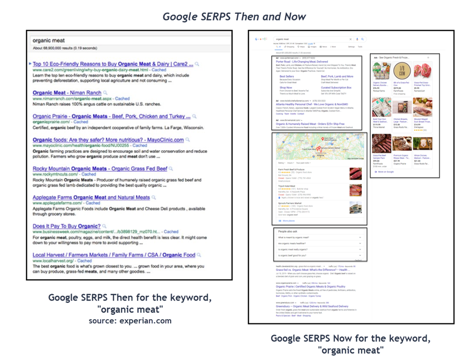When you start having conversations about SEO, you can’t swing a cat without touching on organic CTRs (click-through rates) fairly early on.
When SEOs talk CTRs, there is a specific area we’re referring to.
What is Organic CTR?
Organic CTR is the percentage of impressions that result in a click back to the website. Or put another way, how many searchers click over to your website from Google.
With CTRs, there are a few things we know for sure:
- We as modern searchers (who are impatient, spontaneous, and time-starved), do not go past Page 1. So to get a decent CTR to begin with, you have to rank prominently. On Page 1.
- CTRs have been declining over the years…even when you rank on Page 1.
Why Organic CTRs are Declining
If you have been in the online marketing game for a while, you may remember a time when you could rank on page 1, and you’d automatically get clicks, leads, and sales.
Ah, the good ol’ days.
The trend of organic SEO traffic declining has changed, much of it due to the evolution of the Google SERPS (search engine results page. I know…so many acronyms!).
Here’s what I’m talking about:

If you compare the “Then” versus “Now” in the above image, you can see what I mean. There are so many more features competing for the click back to a website: search ads, shopping ads, the local map pack, PAA (people also ask), …and that’s just on desktop. On mobile, the results are even more personalized, and more varied, with more choices and features that catch the searcher’s eye—taking clicks away from the organic listings.
Hold me.
What Do We Do About Declining Organic SEO Clicks to Our Websites?
This is what’s tough about organic SEO. You can be doing all the right things, hold a respectable place on Page 1, and get fewer clicks than you would’ve generated years ago. Simply because Google has drastically changed the layout of their pages (cough, cough).
The SEO name of the game is evolution and change in order to stay relevant. That is the one constant we should all be used to by now.
Articles and studies about CTRs have been prevalent and frequent in the SEO community over the years.
I wanted to share a recent article, “Why (almost) everything you knew about Google CTR is no longer valid,” that had some interesting findings.
- The average clickrate for the first position in Google is 28.5%
- Beyond position 1 the percentage falls quickly: In the second position, the average clickrate is 15.7% and the in the third position, 11%
- In the tenth position, only an average of 2.5% of people searching click on the result.
- In general, where there are more different elements and integrations in the SERPs, you’ll find lower CTR figures.
- For SEOs it means: The search intention of a keyword defines the SERP layout, and therefore, how many organic clicks you can target. Search volume alone isn’t the decisive figure.
At some point soon, I intend to hold a training to help marketers modernize their brands, update their outdated strategy, and put an action plan in place to accommodate the changes they’re seeing. Figuring out the impact of the SERPs layout for your specific target keywords is part of our role now, and has been for awhile.
Regardless of how we feel about this, we are not complete victims. We do not have to wallow, accepting that we’ll never get organic traffic again. There are things we can do to win back clicks, even if it’s not in the traditional way we used to. You must keep fighting the good fit while also pivoting (who here hates that word now??) evolving and picking up new tactics.
